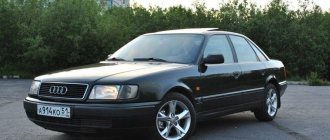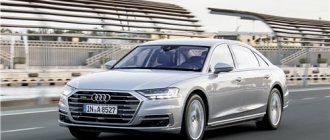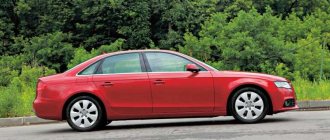Aftermarket: Audi TT 8N
Denis [den10031996]
05.01.2019,
The first generation Audi TT was the dream of many people, which today is feasible, because on the secondary market there are many offers at the price of Solaris. After 20 years, the car still boasts a distinctive style and acceptable dynamics. But I’ll tell you later what you’ll have to face when buying the legendary TT.
History of creation
The car was created on the platform of the 4th generation VW Golf and Audi A3. An excellent chassis and daring appearance - the result is a new car. The TT is the direct successor to the Golf GTI, which are cars with excellent dynamic performance and handling, which is inherent in every real sports car. The new Audi TT got all the best, and also added stiffer suspension, stretched subframes, all-wheel drive and wheels of 16 and 17 radius. However, due to the shape of the body, there was an embarrassment: at a speed of 130 km/h, a strong lifting force appeared, which became a dangerous problem in the form of a tendency to skid. After many complaints, the car was equipped with ESP and a wing.
About the body
After 20 years, the body has become more vulnerable to corrosion, and the area affected by rust is increasing. Rear wheel arches, sills, and windshield frame. The degree of difficulty depends on the severity of the accident, as well as the load on the body from the rigid suspension. But the paintwork is good, even on the pre-restyling version. Paint only fades over time. Most of the cars are weekend toys and are therefore in good condition. Everything that goes at the bottom of the market often “goes from hand to hand” and requires serious investments. The cost of restoring the body is three times more expensive than that of the Golf platform. You need to check the body carefully before purchasing, since its design involves many solutions in the form of weights and poor ventilation, which leads to the formation of corrosion. The headlights are prone to clouding, and you won’t find Chinese analogues. You will also not find bumpers and sill trims among cheap analogues, so these elements should be protected. Be attentive to the condition of door seals, locks and window regulators. Craftsmen often install rubber bands from VAZ.
In the cabin
Mileage and age certainly make themselves felt, which is primarily indicated by the seats, by the way, manufactured by Mercedes-Benz. By the age of honor, most TTs already have rebuilt seat frames and a rebuilt interior. By 200,000 km, the steering wheel leather is slightly worn. All levers and buttons are prone to breakage, but they are interchangeable with parts from other models. But the remaining elements in the form of door sill trims will have to be sourced exclusively from this car. A typical problem is the failure of the instrument panel, which can sometimes be re-soldered. The consequence of such a breakdown will be the inability to start the engine due to an immobilizer error.
About the electrical part
It is difficult to judge the reliability of the electronic part - one half may not have problems for several years, while for others problems are detected immediately. Among the main typical problems:
- burnout of the switching unit when the contact is loosened;
- due to the use of low-quality fuses, engine cooling fans fail;
- the resource of the generator overrunning clutch is no more than 100,000 km;
- frequent failure of the electric pump;
- Haldex control unit.
About suspension, brakes and steering
There are no questions about the brake system; it is simple, reliable, and consumables are not expensive. The suspension on the Audi TT, although stiff, is quite strong, especially if you use original components or quality brands. A reinforced hub assembly requires replacement at least once every 100 thousand km, and non-original hubs last half as long. If the car has standard wheels, then the service life of the suspension elements is more than acceptable, especially since many elements are unified from platform brothers. It will cost a little more to repair the rear suspension on the all-wheel drive version, where the floating silent blocks are the first to fail. The steering does not cause problems, so all the troubles appear at the end of the component life. By the age of 20, there may be leaks of power steering fluid due to corrosion of the lines.
About the transmission
The car's manual transmissions performed well, but not without minor problems. The axle shafts handle torque well, and the CV joints are durable as long as the boots are intact and the lubricant is changed periodically. For those who like to “anneal”, the dual-mass flywheel is a consumable, but the five-speed gearbox on the pre-restyling series does not cause problems. But the transfer case is the problem of all TTs. Due to the fact that they forget to change the oil in it, the bearings become filled with shavings from the gear pair, after which the housing is the last to suffer. Often, a hole for the cardan is welded into the gearbox and the car becomes only front-wheel drive. Pay attention to this.
The automatic transmission here is a six-speed “wet” DSG, for which a torque of 320 N*m is not the limit. The main thing is to change the oil and filter every 40,000 km. Nowadays, the repair and maintenance of such a gearbox is quite high quality, so there shouldn’t be any problems with it.
After restyling, Aisin TF-60 series 09G was installed. Insufficient maintenance and overheating often destroy this box. If you fully service it and operate it correctly, you can forget about the transmission for a long time.
Power line
The car was very lucky with the engines, because it got turbocharged EA113 engines, which differ from each other in turbines and the presence of phase shifters. Weak points may include PCV valves, heat exchanger leaks, Chinese ignition coils and expensive phase adjustment clutches. A 20-valve cylinder head is expensive to repair, but it’s worth repairing the cylinder head once in conjunction with a major engine overhaul, and the engine will last for at least another 250,000 km. The 150-horsepower engine, due to weak boost, has the longest service life. If you do not overheat the engine and immediately carry out comprehensive maintenance, then until the mileage reaches 350,000 there will be no problems with compression and oil loss.
The VR6 engine, 3.2 in volume, began to be installed in 2003. It is naturally aspirated, and when paired with DSG it showed better speed characteristics than turbo engines. Among the problems, you may encounter expensive repairs due to the complex design, as well as the location of the timing chain on the flywheel side, which does not have a good service life. The complex design of the intake manifold often causes leaks and oil leaks, and the catalyst may collapse after 150,000 km, which will lead to a malfunction of the cylinder-piston group. Since the engine, due to its volume and tight engine compartment, operates at critical temperatures, it is better not to increase its power.
Results
The Audi TT is quite an interesting car, which at one time and still attracts the attention of passersby. Most parts and assemblies are interchangeable with the rest of the VAG line, so repairing and servicing the car will not empty your pockets, provided that the previous owner took proper care of the car.
Used Audi TT 8N: hidden corrosion and betrayal of the switching unit
About origins and relatives
The name of the small coupe refers Europeans to the Tourist Trophy race, one of the toughest competitions in the world of motorsports.
The Isle of Man race still brings together motorcyclists and fans, and the name itself epitomizes road racing and has become a byword for many racing series in the past. Russian people, of course, remember our Tula Tokarev, but believe me, this is a sports projectile, structurally close to a weapon, and not vice versa... Creating a coupe on the VW Golf IV/Audi A3 platform was a logical idea: hot hatchbacks are good for everyone, but sometimes the image plays a role against them. And having an excellent chassis, you can also give it a daring appearance - and now you have a new car and new customers. If you regarded the Audi TT as a “cafe racer”, then you were seriously mistaken. This car is the flesh of the Golf GTI/Golf R, cars with excellent handling and dynamics that did not try to “mow” like a sports car, but simply were them, but in the back of the most popular hatchback in Europe. And the Audi TT got all the best: dynamics and handling, and taking into account its higher status, the coupe also received standard subframe stretchers, stiffer suspension, larger wheels and “almost standard” all-wheel drive.
Pictured: Volkswagen Golf V6 '1999–2003 and Volkswagen GTI '2001–03
Of course, there were some embarrassments. Immediately after the release of the model, an aerodynamic nuance was discovered. The beautiful shape of the body with a “flourish” of the roof created a decent lifting force on the rear axle, and at speeds of 130-150 kilometers per hour this became a serious problem for handling - the car became prone to skidding.
Pictured: Audi TT '1998–2006
Factory testers noted the tendency, but... ignored it. Only after a serious scandal in the press did ESP appear in the equipment of all Audi TTs, and for everyone who wanted it, a small wing was installed on the trunk door, preventing a dangerous problem. It cannot be said that practical Europeans lined up for the compact coupe, but the model turned out to be the most popular in its class and the most “real”. As a result, it lasted on the assembly line until now, until most of the competitors were continued.
Pictured: Audi TT Coupe '1998–2003
Many car enthusiasts who know about the “kinship” with the VW Golf perceive the car as just another clone of a bestseller in a funny body, like the VW Beetle New. But the TT is little more than just a sleeker hatchback. By the way, according to the strict classification of bodies, this is exactly it, and not a coupe, because at the back there is a full-fledged luggage compartment door that opens along with the glass. However, what difference does it make... Hardly anyone would dare to call the Porsche 928 a hatchback, just like the 944, and not only does the rear trunk lid open, but also the body is two-volume. So the Audi TT has fully earned the right to be called Coupe.
Advantages and disadvantages
With the power of the engines, everything is definitely in order here - even a 150-horsepower engine on front-wheel drive cars provides dynamics of less than 9 seconds to hundreds, which at the beginning of the 2000s was perceived as a very worthy result. And cars with more powerful versions 1.8T, 3.2 and all-wheel drive are only 0.4-0.5 seconds behind the results of the refined BMW M3 E36, and by a second behind the E46. Don’t forget that tuning products for the 1.8T engine were immediately offered by kits with a power above 350-400 hp, which made the TT a competitor to cars of a completely different class.
Pictured: BMW M3 Coupe (E36) '1995–1998 and BMW M3 Coupe (E46) '2000–2006
But not just dynamics. An excellent chassis can be made even better if you sacrifice “general civilian” values in the form of smoothness, suspension life and spare parts compatibility. Here, too, the designers really got away with it - the powerful versions of the car fully corresponded to their role and were very different from their ancestors. However, a significant amount of practicality remains in these cars, it cannot be erased so easily: you can drive the TT to work every day, and on weekends for track days, in this regard everything is in order.
Pictured: Audi TT 3.2 quattro Coupe '2003–06
If you do not look back at past achievements, then a coupe that is at least 10 years old (the car was produced from 1998 to 2006) looks interesting, but old-fashioned. It almost certainly had been in more than one accident—they didn’t drive such cars slowly. And the cars cannot boast of low mileage, yet this is exactly what “an affordable supercar for every day.”
Pictured: Audi TT Coupe '1998–2003
They traveled a lot, and only occasionally did the owners put the TT in the garage for the winter ( which does not always work for the benefit of safety ). The rarity of the car is already manifesting itself in the form of a shortage of body parts and the high cost of repairing elements of the all-wheel drive transmission.
However, first things first.
Body
Like any Audi of those years, the TT rusts, but very slowly. And yet the body has enough weak points: here are the rear arches, and the sills, and the windshield frame. Everything is complicated by numerous damages in minor and minor accidents, high load from the suspension on supporting structural elements and periodic downtime - in winter or for repair of power units.
Pictured: Audi TT Coupe '1998–2003
The bodies were painted well, even pre-restyling cars lost their shine over the years, but all aggravating factors play their role. The car requires maintenance. Most cars are provided with such care - it is still a favorite toy, and even with a lack of funding, problems do not occur very often.
Front bumper
price for original
37,762 rubles
Body hardware is relatively expensive - it is two to three times more expensive than similar elements from Golf, and is less common. There are problems in the design itself. Thus, the reinforced sills are hidden behind a removable metal sill trim, and the quality of painting of the internal parts leaves much to be desired. For some reason, the rear arches did not always get enough sealant into the rolling; a corrosion center often forms there too.
Poor ventilation of body elements under the bumpers requires special care, and the presence of such interesting elements as a “weight” under the rear bumper also increases the load on the mounting points. In general, there is no reason to relax, the diagnosis should be as thorough as possible, monitoring all signs of recovery after serious accidents, damage to the suspension cups, and, of course, inspecting body elements that are simply vulnerable to corrosion.
Pictured: Audi TT Coupe '2003–06
Easily rubbed optics, which Chinese manufacturers have not mastered, add a little trouble. There are no non-original bumpers either. Maybe tuning ones, but they are more expensive than used standard ones. In general, take care of the attachments: the cost of restoration even after minor impacts is high, and major repairs are generally prohibitively expensive.
Headlight halogen
price for original
21,433 rubles
When accessing the interior, the frameless doors attract attention. As usual, the price to pay for beauty will be increased sealing requirements and load on the window regulator. The cable drive breaks down noticeably more often than usual, but it is inexpensive to repair. And door seals are restored traditionally using collective farm methods - stuffing tubes inside, replacing them with a seal from a VAZ, or buying a used one or a new original one. Doors rarely sag, but lock failures do occur.
On cars before restyling, the control system for locks and windows is frankly capricious; it is afraid of shocks and condensation. And the locks can either simply not close or open the windows at any time in the parking lot. The rear door lock is most often failed by the wiring; it breaks in the corrugation. With side doors, such a nuisance is surprisingly rare, even less common than with platform doors.
Salon
Inside, age is gradually making itself felt. The sports seats (by the way, made by Mercedes-Benz) are holding up well, but on most cars they have already undergone at least one leather restoration and frame overhaul with replacement of cables. A steering wheel with soft leather shows age and mileage much more strongly, but it usually doesn’t reach obvious holes, even with mileages over 200 thousand, the leather only wears away.
Pictured: Interior of Audi TT Coupe '1998–2003
Various salon small things, unfortunately, do not hold up. The buttons and levers are gradually breaking down. This is all inexpensive if you install it from related cars, but some elements, such as door sill trims, are not only fragile, but also rare and expensive.
Pictured: Interior of Audi TT Coupe '2003–06
The most unpleasant thing is the breakdown of the dashboard, a sign of Audi cars of that era. If there is a panel manufactured by Magneti Marelli, then the MC68HC908AZ60 chip that is used in it is not guaranteed. It simply dies due to a manufacturer error. Re-soldering helps, or replacing the dashboard. You shouldn’t think that this kind of breakdown is a trifle; the car simply won’t start due to an immobilizer error if it wasn’t turned off in advance.
The display in the dashboard also fails, it is also changed if necessary, but troubles with letters “falling out” no longer affect anything other than aesthetics. On cars after restyling, this problem was practically overcome.
Pictured: Interior of Audi TT quattro Coupe '2003–06
Problems with the climate system do not happen too often, but they are expensive to treat. On cars with automatic climate control, breakdowns of the electronic control unit and gearmotors are rare, but they are not always easy to repair. Sometimes you have to remove the front panel to gain access to the system's gearboxes and dampers. But damage to the heater radiator and climate system evaporator will require complete disassembly of the interior with a guarantee. The cause of these problems usually lies in long downtime and corrosion of the system due to infrequent replacement of antifreeze. Otherwise, the air conditioner works without failures: the compressor is reliable, and so is the clutch.
Electrics
The reliability of on-board electronics on Audi cars of those years leaves an ambivalent impression. Some people drive for years without problems, some encounter several at once.
For the Audi TT, the real Achilles heel was the switching unit in the engine compartment, where the fuses for the generator and radiator fans are installed. Switching board 1J0 937 617 A simply “burns at work” at the slightest deterioration in contact. Many owners insert an additional positive wire from the generator and another ground into it to reduce the load on the contacts, but the unit still breaks.
Articles / Practice Temperature suicide: why modern engines are doomed to overheat Boiling antifreeze in the radiator, steam, temperature arrow in the red zone - we seem to all know the symptoms of engine overheating and its consequences in the form of a warped cylinder head. The reasons are also long ago... 209774 59 43 07/13/2017
The fuse installation points literally burn out, especially if the fuses are already Chinese, and as a result the radiator fans stop working. Overheating will not take long to occur . The heater fan control unit is also a consumable item; moisture penetrates into it through the contact pad, and then corrosion does its job.
Generators are quite reliable. It’s not their fault that the resource lasts for 200-250 thousand kilometers, it’s just that the mileage of most cars is already very long. But the resource of the overrunning clutch is much shorter; after hundreds of thousands, howling is possible, so it is better to replace the part with a solid roller; the service life of the belt will not change.
The electric pump of the cooling system is also not an example of durability, and it is strongly not recommended to turn it off. On machines with VR6 it is needed to maintain normal engine cooling at low speeds, and on machines with 1.8T it is needed to cool the turbine after stopping. KKK03-04 are very sensitive to overheating, and with these engines the turbines work almost constantly, they need a turbo timer and pumping of antifreeze after the engine is stopped. Moreover, the Bosch pump 0 392 020 039 is not that expensive, about $50, and it lasts for at least five years if you replace the antifreeze on time and avoid overheating.
Pictured: Audi TT Coupe '2003–06
There are quite a lot of failures in machines regarding ABS/ESP; after 10-15 years of service, soldering defects may appear in the blocks, which requires specialized service; it cannot be soldered at home. Breakdowns of the sensors themselves also happen, but there are no particularly vulnerable parts. Unless the rotting ABS combs on the hubs can pose a problem for an unprepared service. However, repair parts are available for sale, and in general this breakdown is inexpensive.
Haldex clutch control units are a separate matter. There is a certain shortage of these parts, which suffer due to leaks and corrosion, as well as short circuits inside the coupling itself. But we will talk about the transmission in the second part.
Brakes, suspension and steering
A braking system without surprises, reliable and inexpensive. And with good efficiency too. True, hard tuning with the installation of rotors and disks from the Q7 and brackets for unknown reasons can create problems for the new owner. Pay attention when purchasing so as not to select parts based on appearance later.
Pictured: Audi TT Coupe '1998–2003
The suspension on the TT is stiff, shaky and... strong. But of course, the resource cannot be compared with the “civilian” options. Even reinforced hubs for 18-inch wheels cannot withstand use on bad roads with low-profile tires. The average service life is less than a hundred thousand mileage, and non-original ones are replaced twice as often.
Front shock absorber
price for original
6,066 rubles
The service life of the front supports and shock absorbers is also less than a hundred thousand, and the service life of the rear “floating” silent blocks on all-wheel drive vehicles is even less. For a simple hatchback this would be a problem, but this is still a small sports car. For them, such a resource for suspension elements is more than good. Moreover, those who drive carefully and do not use ultra-low-profile tires can achieve noticeably higher performance.
Steering rarely causes trouble, except that purely resource-related tapping of the rack occurs on most cars, and pressure line leaks due to corrosion appear more and more often. Nothing unusual for cars of this age.
Pictured: Audi TT Coupe '2003–06
What about engines and gearboxes?
We will talk about the power units of the Audi TT in the second part of the review ! There's a lot of interesting stuff ahead about early Volkswagen turbo engines.










